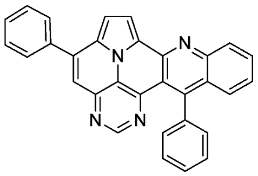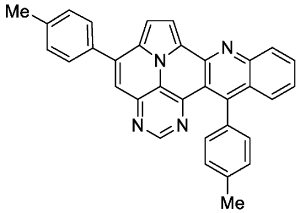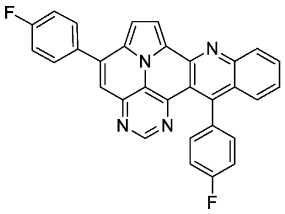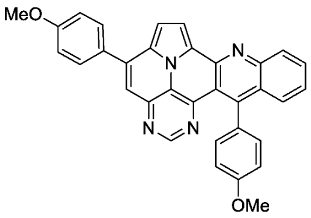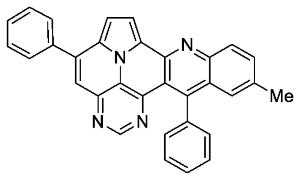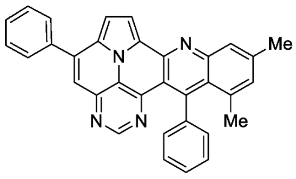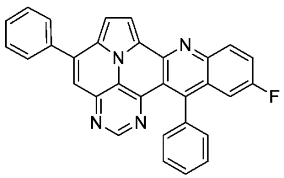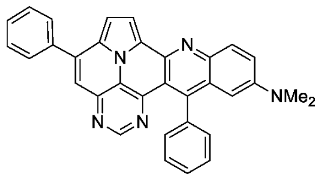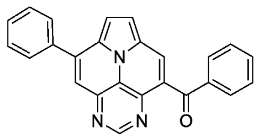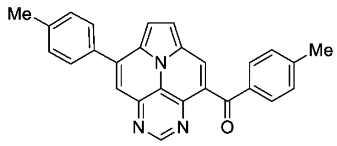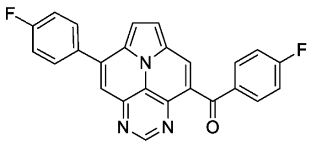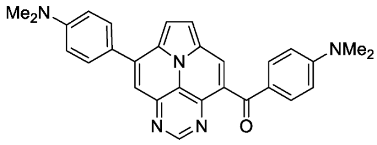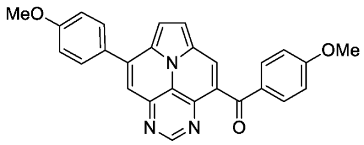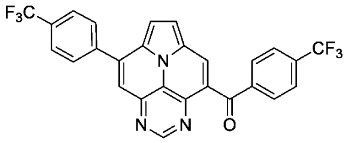Divergent Synthesis of 5,7-Diazaullazines Derivatives through a Combination of Cycloisomerization with Povarov or Alkyne–Carbonyl Metathesis
Abstract
1. Introduction
1.1. Synthesis
1.2. Photophysical Properties
2. Conclusions
3. Materials and Methods
3.1. General Information
3.2. Analytical Data
3.2.1. General Procedure A for the Synthesis of 5,13-Diphenylpyrimido[4′,5′,6′:9,1]pyrrolo[2′,1′,5′:4,5,6]quinolizino[3,2-b]quinoline (5a–l)
- 5,13-diphenylpyrimido[4′,5′,6′:9,1]pyrrolo[2′,1′,5′:4,5,6]quinolizino[3,2-b]quinoline (5a)
- According to general procedure A, the title compound 5a was obtained as an orange solid in 45% yield (54 mg, 0.121 mmol). Rf 0.50 (CH2Cl2/EtOAc 10:1). Mp. 284–286 °C. 1H NMR (500 MHz, CDCl3) δ = 8.83 (s, 1H), 8.31–8.27 (m, 1H), 8.24 (d, J = 4.3 Hz, 1H), 7.89–7.86 (m, 2H), 7.84 (ddd, J = 8.3 Hz, J = 6.6 Hz, J = 1.4 Hz, 1H), 7.66 (dd, J = 8.6 Hz, J = 1.4 Hz, 1H), 7.63–7.54 (m, 7H), 7.46 (ddd, J = 8.3 Hz, J = 6.7 Hz, J = 1.2 Hz, 1H), 7.42 (d, J = 4.3 Hz, 1H), 7.40–7.37 (m, 2H). 13C NMR (126 MHz, CDCl3) δ = 153.4, 150.2, 149.6, 146.9, 146.8, 144.5, 140.9, 138.7, 137.3, 131.5, 129.4, 129.1, 128.9, 128.7, 128.2, 127.9, 127.6, 127.5, 127.2, 126.3, 126.1, 122.1, 117.5, 116.8, 112.2, 109.1. IR (ATR, cm−1): ṽ = 1605 (s), 1578 (m), 1500 (m), 1449 (m), 1405 (m), 863 (m), 777 (s), 734 (s), 705 (vs), 612 (s), 554 (s). MS (EI, 70 eV): m/z (%) = 446 (86, M+), 445 (92), 444 (28), 382 (56), 381 (100), 380 (89), 379 (28), 354 (26), 223 (49), 222 (52), 208 (31). HRMS (ESI-TOF): calculated for C31H19N4 ([M + H]+) 447.1609, found 447.1602.
- 5,13-di-p-tolylpyrimido[4′,5′,6′:9,1]pyrrolo[2′,1′,5′:4,5,6]quinolizino[3,2-b]quinoline (5b)
- According to general procedure A, the title compound 5b was obtained as an orange solid in 42% yield (50 mg, 0.105 mmol). Rf 0.78 (CH2Cl2/EtOAc 15:1). Mp. 303–306 °C. 1H NMR (250 MHz, CDCl3) δ = 8.83 (s, 1H), 8.22–8.16 (m, 1H), 8.13 (d, J = 4.3 Hz, 1H), 7.79–7.69 (m, 3H), 7.64 (ddd, J = 8.7 Hz, J = 1.5 Hz, J = 0.7 Hz, 1H), 7.49 (s, 1H), 7.44–7.35 (m, 5H), 7.33 (d, J = 4.3 Hz, 1H), 7.32–7.21 (m, 2H), 2.60 (s, 3H), 2.48 (s, 3H).13C NMR (63 MHz, CDCl3) δ = 153.3, 150.4, 149.4, 146.8, 146.7, 144.4, 140.7, 139.5, 137.0, 135.6, 134.4, 131.3, 129.7, 128.8, 128.8, 128.6, 128.5, 127.9, 127.4, 127.3, 126.1, 125.8, 121.9, 117.0, 116.7, 112.0, 108.9, 21.5, 21.4. IR (ATR, cm−1): ṽ = 1603 (s),1498 (m), 820 (s), 771 (m), 748 (vs), 734 (s), 725 (s), 612 (s), 556 (s). MS (EI, 70 eV): m/z (%) = 474 (92, M+), 473 (100), 472 (7), 238 (6), 237 (28), 236 (10), 230 (21), 229 (13), 228 (7), 222 (7), 215 (7). HRMS (ESI-TOF): calculated for C33H23N4 ([M + H]+) 475.1923, found 475.1926.
- 5,13-bis(4-fluorophenyl)pyrimido[4′,5′,6′:9,1]pyrrolo[2′,1′,5′:4,5,6]quinolizino[3,2-b]quinoline (5c)
- According to general procedure A, the title compound 5c was obtained as an orange solid in 38% yield (44 mg, 0.091 mmol). Rf 0.78 (CH2Cl2/EtOAc 15:1). Mp. 318–320 °C. 1H NMR (500 MHz, CDCl3) δ = 8.86 (s, 1H), 8.32 (d, J = 8.5 Hz, 1H), 8.27 (d, J = 4.3 Hz, 1H), 7.89–7.84 (m, 3H), 7.68–7.65 (m, 1H), 7.54 (s, 1H), 7.50 (ddd, J = 8.3 Hz, J = 6.6 Hz, J = 1.2 Hz, 1H), 7.38 (d, J = 4.3 Hz, 1H), 7.36–7.28 (m, 6H). 13C NMR (126 MHz, CDCl3) δ = 163.5 (d, J = 250.0 Hz), 162.6 (d, J = 246.3 Hz), 153.4, 149.5, 149.3, 146.8, 146.7, 144.4, 139.9, 134.3 (d, J = 3.6 Hz), 133.3 (d, J = 3.2 Hz), 131.7, 130.4 (d, J = 8.7 Hz), 130.4 (d, J = 8.6 Hz),129.0, 127.6, 127.5, 127.2, 126.3, 126.3, 122.1, 117.5, 116.9, 116.2 (d, J = 21.8 Hz), 115.3 (d, J = 21.6 Hz), 112.4, 109.0. 19F NMR (471 MHz, CDCl3) δ = −111.4, −114.7. IR (ATR, cm−1): ṽ = 1603 (vs),1502 (vs), 1228 (vs), 1158 (s), 835 (vs), 802 (s), 769 (s), 748 (s), 736 (s), 610 (s), 563 (vs). MS (EI, 70 eV): m/z (%) = 482 (67, M+), 481 (100), 480 (42), 453 (13), 241 (27), 240 (71), 231 (16), 226 (37), 225 (32), 217 (16), 216 (17), 213 (14). HRMS (ESI-TOF): calculated for C31H17F2N4 ([M + H]+) 483.1421, found 483.1425.
- 5,13-bis(4-methoxyphenyl)pyrimido[4′,5′,6′:9,1]pyrrolo[2′,1′,5′:4,5,6]quinolizino[3,2-b]quinoline (5e)
- According to general procedure A, the title compound 5e was obtained as an orange solid in 14% yield (16 mg, 0.032 mmol). Rf 0.85 (CH2Cl2/EtOAc 15:1). Mp. 298–301 °C. 1H NMR (250 MHz, CDCl3/TFA) δ = 9.05 (d, J = 4.9 Hz, 1H), 8.92 (s, 1H), 8.61 (d, J = 8.6 Hz, 1H), 8.44 (ddd, J = 8.6 Hz, J = 6.9 Hz, J = 1.4 Hz, 1H), 8.31–8.18 (m, 3H), 8.03–7.90 (m, 3H), 7.39–7.21 (m, 6H), 4.06 (s, 3H), 4.01 (s, 3H). 13C NMR (63 MHz, CDCl3/TFA) δ = 166.0, 163.3, 161.4, 148.6, 146.7, 145.3, 140.6, 140.3, 138.4, 136.1, 131.4, 131.3, 130.8, 130.1, 129.6, 128.1, 127.0, 126.6, 119.9, 119.7, 119.4, 118.4, 116.0, 115.9, 115.1, 111.1, 55.8, 55.7. IR (ATR, cm−1): ṽ = 1601 (s),1498 (s), 1243 (vs), 1175 (vs), 1158 (s), 1024 (vs), 835 (s), 785 (s), 762 (vs), 736 (s), 573 (s), 558 (vs). MS (EI, 70 eV): m/z (%) = 506 (100, M+), 505 (99), 463 (5) 462 (13), 420 (4), 419 (8), 254 (7), 253 (19), 232 (8), 231 (5), 210 (9), 197 (5), 196 (5). HRMS (ESI-TOF): calculated for C33H23N4O2 ([M + H]+) 507.1821, found 507.1828.
- 11-methyl-5,13-diphenylpyrimido[4′,5′,6′:9,1]pyrrolo[2′,1′,5′:4,5,6]quinolizino[3,2-b]quinoline (5g)
- According to general procedure A, the title compound 5g was obtained as an orange solid in 48% yield (59 mg, 0.128 mmol). Rf 0.75 (CH2Cl2/EtOAc 15:1).Mp. 319–322 °C. 1H NMR (500 MHz, CDCl3) δ = 8.80 (s, 1H), 8.17 (d, J = 4.3 Hz, 1H), 8.14 (d, J = 8.6 Hz, 1H), 7.87–7.84 (m, 2H), 7.64–7.54 (m, 7H), 7.53 (s, 1H), 7.40–7.36 (m, 4H), 2.44 (s, 3H). 13C NMR (126 MHz, CDCl3) δ = 153.3, 149.2, 148.2, 146.7, 143.7, 140.7, 138.8, 137.3, 136.1, 134.0, 129.4, 129.0, 128.7, 128.6, 128.6, 128.1, 127.4, 127.3, 127.1, 126.2, 126.2, 122.0, 117.2, 116.7, 111.8, 109.0, 22.0. IR (ATR, cm−1): ṽ = 1607 (s),1554 (m), 1492 (m), 1449 (m), 1403 (m), 1325 (m), 814 (m), 777 (vs), 754 (m), 703 (vs), 596 (m), 556 (s). MS (EI, 70 eV): m/z (%) = 460 (91, M+), 459 (100), 458 (11), 457 (7), 230 (28), 229 (29), 228 (15), 222 (18), 215 (8), 214 (13), 208 (7). HRMS (ESI-TOF): calculated for C32H21N4 ([M + H]+) 461.1766, found 461.1771.
- 9-methyl-5,13-diphenylpyrimido[4′,5′,6′:9,1]pyrrolo[2′,1′,5′:4,5,6]quinolizino[3,2-b]quinoline (5h)
- According to general procedure A, the title compound 5h was obtained as an orange solid in 38% yield (34 mg, 0.074 mmol). Rf 0.80 (CH2Cl2/EtOAc 15:1). Mp. 256–259 °C. 1H NMR (300 MHz, CDCl3) δ = 8.83 (s, 1H), 8.26 (d, J = 4.3 Hz, 1H), 7.92–7.85 (m, 2H), 7.69 (ddd, J = 6.8 Hz, J = 1.5 Hz, J = 1.0 Hz, 1H), 7.65–7.55 (m, 7H), 7.50 (ddd, J = 8.7 Hz, J = 1.5 Hz, J = 0.7 Hz, 1H), 7.43 (d, J = 4.3 Hz, 1H), 7.38–7.32 (m, 3H), 3.0 (s, 3H). 13C NMR (75 MHz, CDCl3) δ = 153.4, 150.1, 148.8, 146.9, 146.8, 143.4, 140.9, 139.1, 137.4, 136.9, 131.3, 129.4, 129.1, 128.7, 128.7, 128.1, 127.4, 127.1, 126.9, 125.8, 125.8, 122.2, 117.2, 116.4, 111.8, 109.0, 18.2. IR (ATR, cm−1): ṽ = 1601 (m),1552 (m), 1447 (m), 1428 (s), 1339 (m), 1323 (m), 781 (s), 762 (vs), 701 (vs), 604 (m), 567 (m), 556 (s). MS (EI, 70 eV): m/z (%) = 460 (81, M+), 459 (100), 458 (6), 457 (6), 445 (7), 230 (16), 229 (18), 228 (8), 222 (10), 214 (8). HRMS (ESI-TOF): calculated for C32H21N4 ([M + H]+) 461.1766, found 461.1775.
- 10,12-dimethyl-5,13-diphenylpyrimido[4′,5′,6′:9,1]pyrrolo[2′,1′,5′:4,5,6]quinolizino[3,2-b]quinoline (5i)
- According to general procedure A, the title compound 5i was obtained as an orange solid in 26% yield (34 mg, 0.072 mmol). Rf 0.82 (CH2Cl2/EtOAc 15:1). Mp. 317–320 °C. 1H NMR (500 MHz, CDCl3/TFA) δ = 9.12 (d, J = 4.9 Hz, 1H), 8.84 (s, 1H), 8.36 (s, 1H), 8.25 (s, 1H), 8.16 (d, J = 4.9 Hz, 1H), 7.95–7.87 (m, 2H), 7.76–7.64 (m, 6H), 7.58 (s, 1H), 7.40–7.35 (m, 2H), 2.77 (s, 3H), 2.15 (s, 3H). 13C NMR (126 MHz, CDCl3/TFA) δ = 165.2, 154.1, 147.5, 147.4, 145.6, 142.6, 142.0, 138.9, 137.5, 136.7, 135.2, 134.2, 132.1, 130.9, 130.4, 130.0, 129.4, 129.3, 127.1, 125.2, 121.3, 119.5, 119.2, 118.1, 117.3, 115.7, 112.8, 25.2, 22.8. IR (ATR, cm−1): ṽ = 1605 (s),1578 (m), 1550 (m), 1504 (m), 1451 (s), 1325 (m), 857 (m), 777 (s), 725 (s), 703 (vs), 558 (m). MS (EI, 70 eV): m/z (%) = 474 (89, M+), 473 (100), 471 (5), 470 (5), 399 (7), 237 (10), 236 (6), 229 (15), 228 (12), 214 (6). HRMS (ESI-TOF): calculated for C33H22N4 ([M + H]+) 475.1923, found 475.1934.
- 11-fluoro-5,13-diphenylpyrimido[4′,5′,6′:9,1]pyrrolo[2′,1′,5′:4,5,6]quinolizino[3,2-b]quinoline (5j)
- According to general procedure A, the title compound 5j was obtained as an orange solid in 55% yield (69 mg, 0.148 mmol). Rf 0.79 (CH2Cl2/EtOAc 15:1). Mp. 348–350 °C. 1H NMR (500 MHz, CDCl3) δ = 8.85 (s, 1H), 8.32 (dd, J = 9.3 Hz, J = 5.5 Hz, 1H), 8.24 (d, J = 4.3 Hz, 1H), 7.91–7.86 (m, 2H), 7.67–7.55 (m, 8H), 7.44 (d, J = 4.3 Hz, 1H), 7.38–7.35 (m, 2H), 7.26 (dd, J = 10.3 Hz, J = 2.8 Hz, 1H). 13C NMR (126 MHz, CDCl3) δ = 160.1 (d, J = 248.7 Hz), 153.5, 149.5, 149.5, 147.0, 146.8, 146.4, 144.1 (d, J = 1.9 Hz), 141.1, 138.3, 137.3, 131.5 (d, J = 8.9 Hz), 129.5, 129.1, 128.7, 128.5, 128.4, 127.9 (d, J = 9.5 Hz), 127.8, 127.6, 126.2, 122.4 (d, J = 26.2 Hz), 117.5, 117.2, 112.0, 110.7 (d, J = 23.6 Hz), 109.2. 19F NMR (471 MHz, CDCl3) δ = −111.7. IR (ATR, cm−1): ṽ = 1488 (s),1175 (s), 830 (s), 777 (vs), 725 (s), 705 (vs), 593 (s), 552 (s), 474 (s), 460 (s), 443 (s). MS (EI, 70 eV): m/z (%) = 464 (89, M+), 463 (100), 462 (25), 435 (12), 232 (41), 231 (42), 230 (10), 218 (11), 217 (19). HRMS (ESI-TOF): calculated for C31H18FN4 ([M + H]+) 465.1516, found 465.1524.
- N,N-dimethyl-5,13-diphenylpyrimido[4′,5′,6′:9,1]pyrrolo[2′,1′,5′:4,5,6]quinolizino[3,2-b]quinolin-11-amine (5k)
- According to general procedure A, the title compound 5k was obtained as an orange solid in 8% yield (11 mg, 0.021 mmol). Rf 0.82 (CH2Cl2/EtOAc 15:1). Mp. 130–134 °C. 1H NMR (500 MHz, CDCl3) δ = 8.81 (s, 1H), 8.25 (s, 2H), 7.91–7.88 (m, 2H), 7.62–7.57 (m, 5H), 7.57–7.55 (m, 3H), 7.45 (d, J = 4.3 Hz, 1H), 7.41–7.35 (m, 2H), 6.55 (d, J = 2.8 Hz, 1H), 2.96 (s, 6H). 13C NMR (126 MHz, CDCl3/TFA) δ = 148.3, 146.8, 146.7, 145.8, 138.9, 137.4, 134.9, 134.2, 134.0, 132.2, 130.8, 130.3, 130.1, 130.0, 129.8, 129.6, 129.3, 126.8, 122.4, 121.5, 120.4, 118.8, 117.8, 116.6, 112.0, 42.9. IR (ATR, cm−1): ṽ = 2920 (s),1607 (s), 1492 (s), 1449 (s), 1323 (s), 1123 (s), 775 (s), 699 (vs), 591 (s), 554 (s).MS (EI, 70 eV): m/z (%) = 489 (40, M+), 488 (24), 207 (14), 57 (25), 55 (20), 44 (100), 43 (28), 41 (23). HRMS (ESI-TOF): calculated for C33H24N5 ([M + H]+) 490.3032, found 490.2031.
- 5,13-diphenyl-11-(trifluoromethyl)pyrimido[4′,5′,6′:9,1]pyrrolo[2′,1′,5′:4,5,6]quinolizino[3,2-b]quinoline (5l)
- According to general procedure A, the title compound 5l was obtained as an orange solid in 28% yield (38 mg, 0.075 mmol). Rf 0.85 (CH2Cl2/EtOAc 15:1). Mp. 311–313 °C. 1H NMR (500 MHz, CDCl3/TFA) δ = 9.10 (d, J = 4.9 Hz, 1H), 8.96 (s, 1H), 8.77 (d, J = 8.9 Hz, 1H), 8.56 (dd, J = 9.1 Hz, J = 1.8 Hz, 1H), 8.37 (s, 1H), 8.31 (s, 1H), 8.28 (d, J = 4.9 Hz, 1H), 7.95–7.89 (m, 2H), 7.86–7.82 (m, 1H), 7.81–7.71 (m, 5H), 7.41–7.37 (m, 2H). 13C NMR (126 MHz, CDCl3/TFA) δ = 167.4, 149.3, 147.4, 145.8, 141.4, 138.6, 137.3, 135.9 (q, J = 3.1 Hz), 133.8, 133.8, 132.7, 132.2, 132.1 (q, J = 34.7 Hz), 131.2, 130.3, 129.8, 129.4, 128.2 (q, J = 4.1 Hz), 127.1, 127.0, 122.4 (q, J = 273.1 Hz), 121.9, 121.5, 120.6, 119.7, 118.8, 116.9, 113.0. 19F NMR (471 MHz, CDCl3/TFA) δ = −63.8. IR (ATR, cm−1): ṽ = 1609 (m), 1311 (s), 1298 (s), 1117 (vs), 1067 (s), 985 (m), 837 (s), 779 (s), 701 (vs), 589 (s), 556 (s). MS (EI, 70 eV): m/z (%) = 514 (86, M+), 513 (100), 512 (5), 485 (5), 445 (4), 257 (11), 256 (14), 223 (4), 222 (13), 221 (4), 208 (5), 207 (4). HRMS (ESI-TOF): calculated for C32H18F3N4 ([M + H]+) 515.1483, found 515.1495.
3.2.2. General Procedure B for the Synthesis of Aryl(8-arylpyrimido[4,5,6-ij]pyrrolo[2,1,5-de]quinolizin-4-yl)methanone (6a–f)
- Phenyl(8-phenylpyrimido[4,5,6-ij]pyrrolo[2,1,5-de]quinolizin-4-yl)methanone (6a)
- According to general procedure B, the title compound 6a was obtained as a yellow solid in 68% yield (68 mg, 0.182 mmol). Rf 0.48 (heptane/EtOAc 1:2). Mp. 266–269 °C. 1H NMR (250 MHz, CDCl3) δ = 9.14 (s, 1H), 8.52 (s, 1H), 7.99–7.94 (m, 2H), 7.93 (s, 1H), 7.90–7.84 (m, 2H), 7.75–7.69 (m, 2H), 7.67–7.57 (m, 4H), 7.52–7.44 (m, 2H). 13C NMR (63 MHz, CDCl3) δ = 194.4, 155.1, 147.2, 144.9, 140.6, 137.2, 136.9, 133.5, 130.1, 129.6, 129.2, 128.9, 128.6, 128.1, 127.7, 126.3, 126.3, 124.7, 119.8, 113.9, 113.2. IR (ATR, cm−1): ṽ = 1644 (m), 1609 (s), 1455 (s), 1261 (s), 1238 (s), 1045 (s), 795 (s), 779 (s), 684 (vs), 637 (vs), 563 (vs). MS (EI, 70 eV): m/z (%) = 373 (16, M+), 372 (29), 346 (7), 345 (28), 344 (100), 316 (5), 240 (10), 187 (16), 172 (8). HRMS (ESI-TOF): calculated for C25H15N3O ([M + H]+) 374.1293, found 374.1294.
- p-tolyl(8-(p-tolyl)pyrimido[4,5,6-ij]pyrrolo[2,1,5-de]quinolizin-4-yl)methanone (6b)
- According to general procedure B, the title compound 6b was obtained as a yellow solid in 54% yield (54 mg, 0.135 mmol). Rf 0.52 (heptane/EtOAc 1:2). Mp. 258–261 °C. 1H NMR (300 MHz, CDCl3) δ = 9.12 (s, 1H), 8.47 (s, 1H), 7.88 (s, 1H), 7.86 (d, J = 8.3 Hz, 2H), 7.76 (d, J = 8.1 Hz, 2H), 7.73–7.66 (m, 2H), 7.45–7.39 (m, 2H), 7.30–7.21 (m, 2H), 2.50 (s, 3H), 2.43 (s, 3H). 13C NMR (75 MHz, CDCl3) δ = 194.0, 155.1, 147.2, 144.8, 144.5, 140.5, 139.8, 134.6, 134.0, 130.3, 129.9, 129.2, 128.8, 128.4, 127.6, 126.2, 125.9, 124.6, 119.4, 113.6, 113.1, 21.7, 21.3. IR (ATR, cm−1): ṽ = 1607 (s), 1457 (s), 1344 (vs), 1267 (s), 1251 (s), 1043 (s), 903 (s), 824 (s), 777 (vs), 756 (s), 723 (s), 563 (vs). MS (EI, 70 eV): m/z (%) = 401 (19, M+), 400 (28), 373 (31), 372 (100), 371 (9), 201 (12), 186 (8), 179 (6), 178 (11), 91 (7). HRMS (ESI-TOF): calculated for C27H19N3O ([M + H]+) 402.1606, found 402.1602.
- (4-fluorophenyl)(8-(4-fluorophenyl)pyrimido[4,5,6-ij]pyrrolo[2,1,5-de]quinolizin-4-yl)methanone (6c)
- According to general procedure B, the title compound 6c was obtained as a yellow solid in 71% yield (71 mg, 0.173 mmol). Rf 0.48 (heptane/EtOAc 1:2). Mp. 317–320 °C. 1H NMR (500 MHz, CDCl3/TFA) δ = 9.25 (s, 1H), 9.17 (s, 1H), 8.63 (s, 1H), 8.41 (d, J = 5.0 Hz, 1H), 8.35 (d, J = 5.0 Hz, 1H), 8.00–7.87 (m, 4H), 7.44 (pt, J = 8.3 Hz, 2H), 7.30 (pt, J = 8.3 Hz, 2H). 13C NMR (126 MHz, CDCl3/TFA) δ = 193.9, 166.6 (d, J = 258.6 Hz), 164.9 (d, J = 254.6 Hz), 146.3, 144.6, 143.6, 136.7, 132.8 (d, J = 9.7 Hz), 131.9 (d, J = 8.9 Hz), 131.7, 130.6, 130.4, 130.3, 129.9, 122.9, 121.9, 121.2, 118.2, 117.5 (d, J = 22.1 Hz), 116.7 (d, J = 22.3 Hz). 19F NMR (471 MHz, CDCl3/TFA) δ = −101.5, −107.3. IR (ATR, cm−1): ṽ = 1609 (s), 1599 (s), 1589 (s), 1508 (s), 1453 (s), 1267 (s), 1243 (vs), 1232 (s), 1158 (s), 847 (s), 837 (s), 783 (vs), 563 (s). MS (EI, 70 eV): m/z (%) = 409 (14, M+), 408 (17), 382 (4), 381 (27), 380 (100), 379 (7), 259 (4), 258 (10), 205 (7), 190 (4), 95 (9). HRMS (ESI-TOF): calculated for C25H14F2N3O ([M + H]+) 410.1105, found 410.1113.
- (4-(dimethylamino)phenyl)(8-(4-(dimethylamino)phenyl)pyrimido[4,5,6-ij]pyrrolo[2,1,5-de]quinolizin-4-yl)methanone (6d)
- According to general procedure B, the title compound 6d was obtained as a yellow solid in 54% yield (54 mg, 0.118 mmol). Rf 0.29 (EtOAc). Mp. 255–258 °C. 1H NMR (500 MHz, CDCl3) δ = 9.11 (s, 1H), 8.39 (s, 1H), 7.91–7.75 (m, 6H), 7.63 (d, J = 4.6 Hz, 1H), 6.94–6.88 (m, 2H), 6.67–6.61 (m, 2H), 3.09 (s, 6H), 3.07 (s, 6H). 13C NMR (126 MHz, CDCl3) δ = 192.2, 155.0, 153.9, 151.2, 147.2, 144.6, 140.8, 132.7, 130.0, 129.7, 127.4, 126.4, 124.8, 124.7, 124.3, 124.3, 117.5, 113.1, 112.8, 112.4, 110.6, 40.3, 40.0. IR (ATR, cm−1): ṽ = 1597 (vs), 1523 (s), 1346 (s), 1284 (s), 1271 (s), 1261 (s), 1189 (s), 1179 (s), 1168 (s), 818 (s), 779 (s), 771 (s), 560 (s). MS (EI, 70 eV): m/z (%) = 459 (53, M+), 458 (39), 445 (22), 444 (28), 431 (34), 430 (100), 416 (35), 414 (16), 230 (18), 215 (13). HRMS (ESI-TOF): calculated for C29H26N5O ([M + H]+) 460.2137, found 460.2148.
- (4-methoxyphenyl)(8-(4-methoxyphenyl)pyrimido[4,5,6-ij]pyrrolo[2,1,5-de]quinolizin-4-yl)methanone (6e)
- According to general procedure B, the title compound 6e was obtained as a yellow solid in 51% yield (51 mg, 0.118 mmol). Rf 0.29 (heptane/EtOAc 1:3). Mp. 265–267 °C. 1H NMR (300 MHz, CDCl3) δ = 9.27 (s, 1H), 9.14 (s, 1H), 8.64 (s, 1H), 8.46–8.40 (m, 2H), 7.96–7.84 (m, 4H), 7.26 (d, J = 8.9 Hz, 2H), 7.10 (d, J = 8.3 Hz, 2H), 3.99 (s, 3H), 3.95 (s, 3H). 13C NMR (75 MHz, CDCl3) δ = 194.3, 165.4, 162.7, 146.3, 145.8, 143.0, 135.7, 133.1, 131.8, 131.7, 130.5, 130.1, 127.8, 126.6, 123.1, 122.9, 122.0, 121.1, 118.1, 115.8, 114.9, 55.8, 55.7. IR (ATR, cm−1): ṽ = 1597 (s), 1455 (s), 1253 (vs), 1166 (vs), 1041 (s), 1020 (s), 832 (s), 775 (s), 604 (s), 575 (s), 560 (s), 536 (s). MS (EI, 70 eV): m/z (%) = 433 (16, M+), 432 (20), 405 (26), 404 (100), 389 (11), 361 (13), 217 (26), 180 (9), 265 (7). HRMS (ESI-TOF): calculated for C27H20N3O3 ([M + H]+) 434.1505, found 434.1518.
- (4-(trifluoromethyl)phenyl)(8-(4-(trifluoromethyl)phenyl)pyrimido[4,5,6-ij]pyrrolo[2,1,5-de]quinolizin-4-yl)methanone (6f)
- According to general procedure B, the title compound 6f was obtained as a yellow solid in 62% yield (62 mg, 0.121 mmol). Rf 0.52 (heptane/EtOAc 1:2). Mp. 309–311 °C. 1H NMR (500 MHz, CDCl3/TFA) δ = 9.23 (s, 1H), 9.18 (s, 1H), 8.66 (s, 1H), 8.41 (d, J = 5.0 Hz, 1H), 8.30 (d, J = 5.0 Hz, 1H), 8.04 (d, J = 8.1 Hz, 2H), 8.02–7.94 (m, 4H), 7.85 (d, J = 7.9 Hz, 2H). 13C NMR (126 MHz, CDCl3) δ = 194.3, 146.2, 144.1, 143.8, 138.8, 137.6, 137.0, 135.3 (q, J = 33.0 Hz), 133.4 (q, J = 33.3 Hz), 131.7, 130.9, 130.2, 130.0, 129.9, 126.9 (q, J = 3.8 Hz), 126.2 (q, J = 3.8 Hz), 123.6, 123.5 (q, J = 272.7 Hz), 123.3, 123.3 (q, J = 272.9 Hz), 122.6, 120.8, 117.8. 19F NMR (471 MHz, CDCl3) δ = −63.2, −63.5. IR (ATR, cm−1): ṽ = 1325 (vs), 1166 (s), 1109 (vs), 1067 (s), 1057 (s), 1049 (s), 1018 (s), 845 (m), 787 (s), 670 (m), 563 (m). MS (EI, 70 eV): m/z (%) = 509 (12, M+), 508 (20), 482 (5), 481 (28), 480 (100), 255 (7), 240 (8), 145 (9). HRMS (ESI-TOF): calculated for C27H14F6N3O ([M + H]+) 510.1041, found 510.1055.
Supplementary Materials
Author Contributions
Funding
Institutional Review Board Statement
Informed Consent Statement
Data Availability Statement
Conflicts of Interest
References
- Delcamp, J.H.; Yella, A.; Holcombe, T.W.; Nazeeruddin, M.K.; Grätzel, M. The molecular engineering of organic sensitizers for solar-cell applications. Angew. Chem. Int. Ed. 2013, 52, 376–380. [Google Scholar] [CrossRef] [PubMed]
- Balli, H.; Zeller, M. Neue Heteroarene: Synthese und spektrale Daten von Indolizino[6,5,4,3-aij ]chinolin («Ullazin») und einigen Derivaten. Helv. Chim. Acta 1983, 66, 2135–2139. [Google Scholar] [CrossRef]
- Feng, J.; Jiao, Y.; Ma, W.; Nazeeruddin, M.K.; Grätzel, M.; Meng, S. First Principles Design of Dye Molecules with Ullazine Donor for Dye Sensitized Solar Cells. J. Phys. Chem. C 2013, 117, 3772–3778. [Google Scholar] [CrossRef]
- Zhang, Y.; Cheema, H.; McNamara, L.; Hunt, L.A.; Hammer, N.I.; Delcamp, J.H. Ullazine Donor-π bridge-Acceptor Organic Dyes for Dye-Sensitized Solar Cells. Chem. Eur. J. 2018, 24, 5939–5949. [Google Scholar] [CrossRef] [PubMed]
- Cebrián, C. Ullazine-based materials: Towards novel opportunities in organic electronics. J. Mater. Chem. C 2018, 6, 11943–11950. [Google Scholar] [CrossRef]
- Li, Y.; Li, X.; Xu, Y. Theoretical screening of high-efficiency sensitizers with D-π-A framework for DSSCs by altering promising donor group. Sol. Energy. 2020, 196, 146–156. [Google Scholar] [CrossRef]
- Le Bao, Q.; Thogiti, S.; Koyyada, G.; Kim, J.H. Synthesis and photovoltaic performance of novel ullazine-based organic dyes for dye-sensitized solar cells. Jpn. J. Appl. Phys. 2019, 58, 12011. [Google Scholar] [CrossRef]
- Das, A.; Ghosh, I.; König, B. Synthesis of pyrrolo1,2-aquinolines and ullazines by visible light mediated one- and twofold annulation of N-arylpyrroles with arylalkynes. Chem. Commun. 2016, 52, 8695–8698. [Google Scholar] [CrossRef] [PubMed]
- Pierrat, P.; Hesse, S.; Cebrián, C.; Gros, P.C. Controlling charge-transfer properties through a microwave-assisted mono- or bis-annulation of dialkynyl-N-(het)arylpyrroles. Org. Biomol. Chem. 2017, 15, 8568–8575. [Google Scholar] [CrossRef]
- Kanno, K.; Liu, Y.; Iesato, A.; Nakajima, K.; Takahashi, T. Chromium-mediated synthesis of polycyclic aromatic compounds from halobiaryls. Org. Lett. 2005, 7, 5453–5456. [Google Scholar] [CrossRef]
- Drigo, N.A.; Paek, S.; Huckaba, A.J.; Schouwink, P.A.; Tabet, N.; Nazeeruddin, M.K. Approaches for Selective Synthesis of Ullazine Donor-Acceptor Systems. Chem. Eur. J. 2017, 23, 17209–17212. [Google Scholar] [CrossRef] [PubMed]
- Zhang, G.; Gautam, P.; Chan, J.M.W. Symmetrical and unsymmetrical fluorine-rich ullazines via controlled cycloaromatizations. Org. Chem. Front. 2020, 7, 787–795. [Google Scholar] [CrossRef]
- Qiao, H.; Deng, Y.; Peng, R.; Wang, G.; Yuan, J.; Tan, S. Effect of π-spacers and anchoring groups on the photovoltaic performances of ullazine-based dyes. RSC Adv. 2016, 6, 70046–70055. [Google Scholar] [CrossRef]
- Wan, D.; Li, X.; Jiang, R.; Feng, B.; Lan, J.; Wang, R.; You, J. Palladium-Catalyzed Annulation of Internal Alkynes: Direct Access to π-Conjugated Ullazines. Org. Lett. 2016, 18, 2876–2879. [Google Scholar] [CrossRef] [PubMed]
- Richter, M.; Fu, Y.; Dmitrieva, E.; Weigand, J.J.; Popov, A.; Berger, R.; Liu, J.; Feng, X. Polycyclic Aromatic Hydrocarbons Containing A Pyrrolopyridazine Core. ChemPlusChem 2019, 84, 613–618. [Google Scholar] [CrossRef]
- Liu, J.; Feng, X. Bottom-Up Synthesis of Nitrogen-Doped Polycyclic Aromatic Hydrocarbons. Synlett 2020, 31, 211–222. [Google Scholar] [CrossRef]
- Berger, R.; Wagner, M.; Feng, X.; Müllen, K. Polycyclic aromatic azomethine ylides: A unique entry to extended polycyclic heteroaromatics. Chem. Sci. 2015, 6, 436–441. [Google Scholar] [CrossRef] [PubMed]
- Ito, S.; Tokimaru, Y.; Nozaki, K. Isoquinolino4,3,2-dephenanthridine: Synthesis and its use in 1,3-dipolar cycloadditions to form nitrogen-containing polyaromatic hydrocarbons. Chem. Commun. 2015, 51, 221–224. [Google Scholar] [CrossRef] [PubMed]
- Tokimaru, Y.; Ito, S.; Nozaki, K. Synthesis of Pyrrole-Fused Corannulenes: 1,3-Dipolar Cycloaddition of Azomethine Ylides to Corannulene. Angew. Chem. Int. Ed. 2017, 56, 15560–15564. [Google Scholar] [CrossRef]
- Hager, J.; Kang, S.; Chmielewski, P.J.; Lis, T.; Kim, D.; Stępień, M. Acenaphthylene-fused ullazines: Fluorescent π-extended monopyrroles with tunable electronic gaps. Org. Chem. Front. 2022, 9, 3179–3185. [Google Scholar] [CrossRef]
- Miao, D.; Aumaitre, C.; Morin, J.-F. Photochemical synthesis of π-extended ullazine derivatives as new electron donors for efficient conjugated D–A polymers. J. Mater. Chem. C 2019, 7, 3015–3024. [Google Scholar] [CrossRef]
- Hou, D.; Balli, H. A Novel Heterocyclic Ring System: Synthesis and Spectral Data of 4,8,9b-Triazacyclopenta[c,d]phenalene. Helv. Chim. Acta 1992, 75, 2608–2612. [Google Scholar] [CrossRef]
- Janke, S.; Boldt, S.; Nakielski, P.; Villinger, A.; Ehlers, P.; Langer, P. Synthesis and Properties of 5-Azaullazines. J. Org. Chem. 2023, 88, 10470–10482. [Google Scholar] [CrossRef] [PubMed]
- Boldt, S.; Parpart, S.; Villinger, A.; Ehlers, P.; Langer, P. Synthesis and Properties of Aza-ullazines. Angew. Chem. Int. Ed. 2017, 56, 4575–4578. [Google Scholar] [CrossRef]
- Ge, Q.; Li, B.; Wang, B. Synthesis of substituted benzoijimidazo2,1,5-dequinolizine by rhodium(III)-catalyzed multiple C-H activation and annulations. Org. Biomol. Chem. 2016, 14, 1814–1821. [Google Scholar] [CrossRef] [PubMed]
- Davies, D.L.; Ellul, C.E.; Macgregor, S.A.; McMullin, C.L.; Singh, K. Experimental and DFT Studies Explain Solvent Control of C-H Activation and Product Selectivity in the Rh(III)-Catalyzed Formation of Neutral and Cationic Heterocycles. J. Am. Chem. Soc. 2015, 137, 9659–9669. [Google Scholar] [CrossRef] [PubMed]
- Li, C.; Liu, Y.; Sun, Z.; Zhang, J.; Liu, M.; Zhang, C.; Zhang, Q.; Wang, H.; Liu, X. Synthesis, Characterization, and Properties of Bis-BN Ullazines. Org. Lett. 2018, 20, 2806–2810. [Google Scholar] [CrossRef] [PubMed]
- Guo, Y.; Zhang, L.; Li, C.; Jin, M.; Zhang, Y.; Ye, J.; Chen, Y.; Wu, X.; Liu, X. BN/BO-Ullazines and Bis-BO-Ullazines: Effect of BO Doping on Aromaticity and Optoelectronic Properties. J. Org. Chem. 2021, 86, 12507–12516. [Google Scholar] [CrossRef] [PubMed]
- Polkaehn, J.; Molenda, R.; Cordero, M.A.; Lochbrunner, S.; Boldt, S.; Ehlers, P.; Villinger, A.; Langer, P. Synthesis and Properties of 5,7-Diazaullazines. J. Org. Chem. 2024, 89, 2169–2181. [Google Scholar] [CrossRef]
- Polkaehn, J.; Thom, R.; Ehlers, P.; Villinger, A.; Langer, P. π-Expanded azaullazines: Synthesis of quinolino-azaullazines by Povarov reaction and cycloisomerisation. Org. Biomol. Chem. 2024. [Google Scholar] [CrossRef]
- Spruner von Mertz, F.; Molenda, R.; Boldt, S.; Villinger, A.; Ehlers, P.; Langer, P. Synthesis and Properties of Diphenylbenzojnaphtho2,1,8-def2,7phenanthrolines. Chem. Eur. J. 2023, 29, e202204011. [Google Scholar] [CrossRef] [PubMed]
- Chen, J.; Li, J.; Xie, L.; Fan, H.; Sheng, X.; Du, Y.; Liu, G.; Hu, H.; Jiang, Y.; Chen, M. Iron-catalyzed divergent approach to naphthyridinones and quinolinones: Leveraging Povarov and carbonyl-alkyne metathesis reactions of electron deficient alkynes. Org. Chem. Front. 2023, 10, 5505–5511. [Google Scholar] [CrossRef]
- Chakraborty, B.; Kar, A.; Chanda, R.; Jana, U. Application of the Povarov Reaction in Biaryls under Iron Catalysis for the General Synthesis of Dibenzoa, cAcridines. J. Org. Chem. 2020, 85, 9281–9289. [Google Scholar] [CrossRef] [PubMed]
- Sobhani, M.; Frey, A.; Rettmann, A.; Thom, R.; Villinger, A.; Ehlers, P.; Langer, P. Synthesis of Dibenzotropones by Alkyne-Carbonyl Metathesis. J. Org. Chem. 2021, 86, 14420–14432. [Google Scholar] [CrossRef]
- CCDC 2332651 Contains the Supplementary Crystallographic Data for This Paper. Available online: www.ccdc.cam.ac.uk/data_request/cif (accessed on 19 February 2024).
- Paenurk, E.; Gershoni-Poranne, R. Simple and efficient visualization of aromaticity: Bond currents calculated from NICS values. Phys. Chem. Chem. Phys. 2022, 24, 8631–8644. [Google Scholar] [CrossRef]
- Schleyer, P.v.R.; Maerker, C.; Dransfeld, A.; Jiao, H.; van Eikema Hommes, N.J.R. Nucleus-Independent Chemical Shifts: A Simple and Efficient Aromaticity Probe. J. Am. Chem. Soc. 1996, 118, 6317–6318. [Google Scholar] [CrossRef] [PubMed]
- Brouwer, A.M. Standards for photoluminescence quantum yield measurements in solution (IUPAC Technical Report). Pure Appl. Chem. 2011, 83, 2213–2228. [Google Scholar] [CrossRef]
- Vardanyan, A.; Boldt, S.; Villinger, A.; Ehlers, P.; Langer, P. Synthesis and Properties of 1-Azapyrenes. J. Org. Chem. 2022, 87, 11296–11308. [Google Scholar] [CrossRef] [PubMed]
- Vardanyan, A.; Argüello Cordero, M.A.; Lochbrunner, S.; Villinger, A.; Ehlers, P.; Langer, P. Synthesis and Properties of 4- and 10-Benzoyl-1-azapyrenes. J. Org. Chem. 2024, 89, 2155–2168. [Google Scholar] [CrossRef]
- Parpart, S.; Boldt, S.; Ehlers, P.; Langer, P. Synthesis of Unsymmetrical Aza-Ullazines by Intramolecular Alkynyl-Carbonyl Metathesis. Org. Lett. 2018, 20, 122–125. [Google Scholar] [CrossRef]
- Pommerehne, J.; Vestweber, H.; Guss, W.; Mahrt, R.F.; Bässler, H.; Porsch, M.; Daub, J. Efficient two layer leds on a polymer blend basis. Adv. Mater. 1995, 7, 551–554. [Google Scholar] [CrossRef]
- Frisch, M.J.; Trucks, G.W.; Schlegel, H.B.; Scuseria, G.E.; Robb, M.A.; Cheeseman, J.R.; Scalmani, G.; Barone, V.; Petersson, G.A.; Nakatsuji, H.; et al. Gaussian 16 Rev. C.01; Gaussian, Inc.: Wallingford, CT, USA, 2016. [Google Scholar]
- Xiang, J.; Zheng, L.; Chen, F.; Dang, Q.; Bai, X. A cascade reaction consisting of Pictet-Spengler-type cyclization and Smiles rearrangement: Application to the synthesis of novel pyrrole-fused dihydropteridines. Org. Lett. 2007, 9, 765–767. [Google Scholar] [CrossRef] [PubMed]
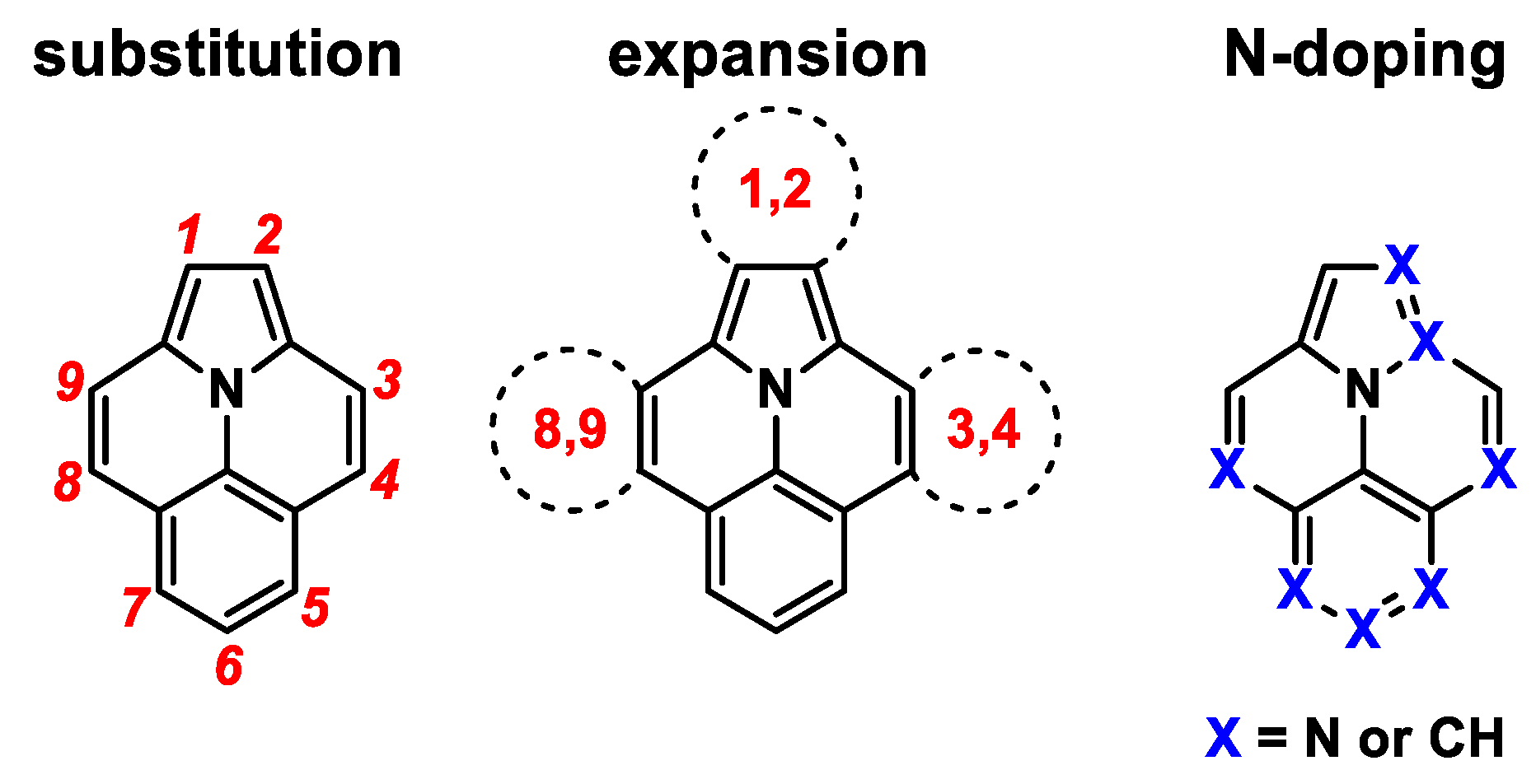


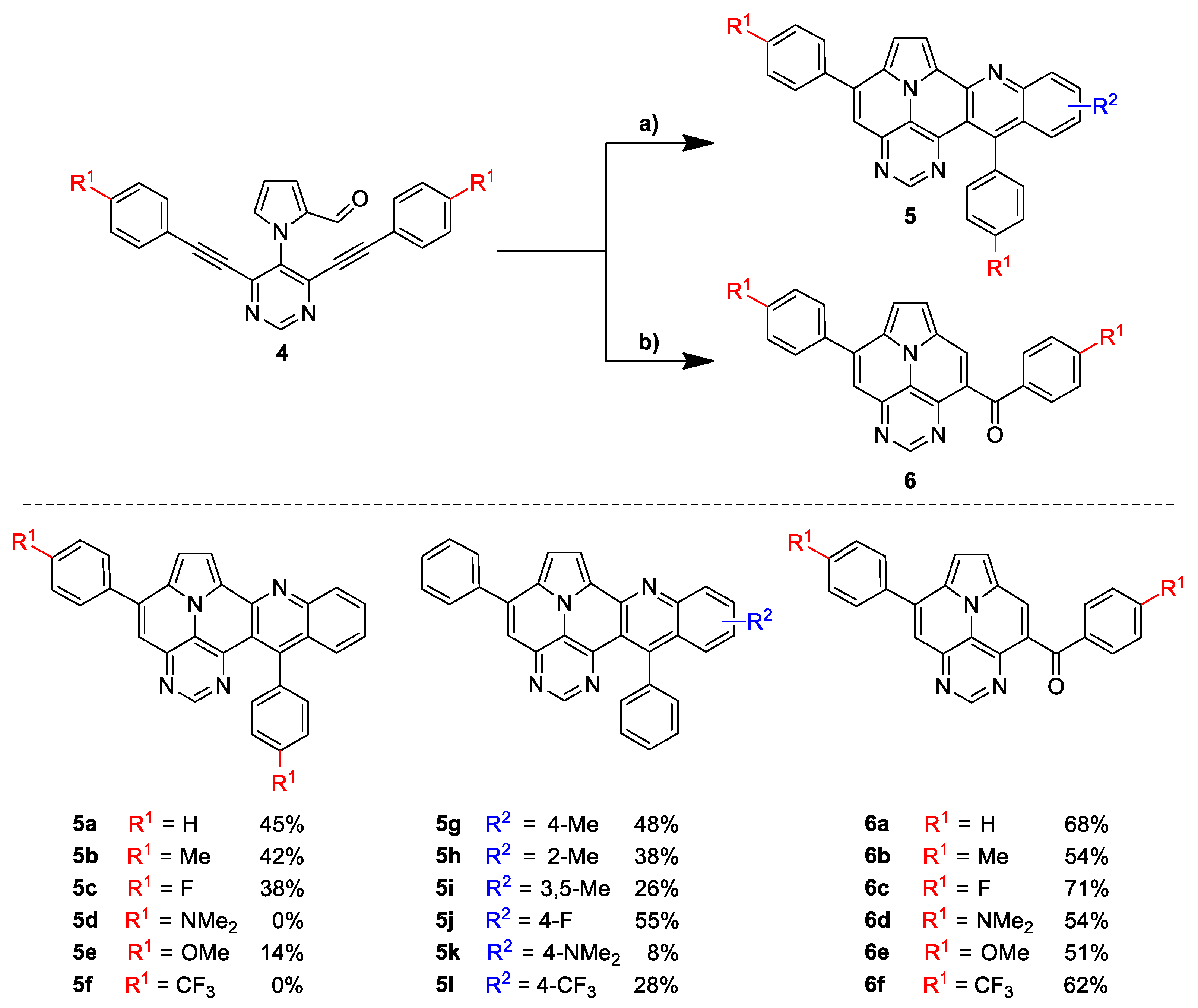



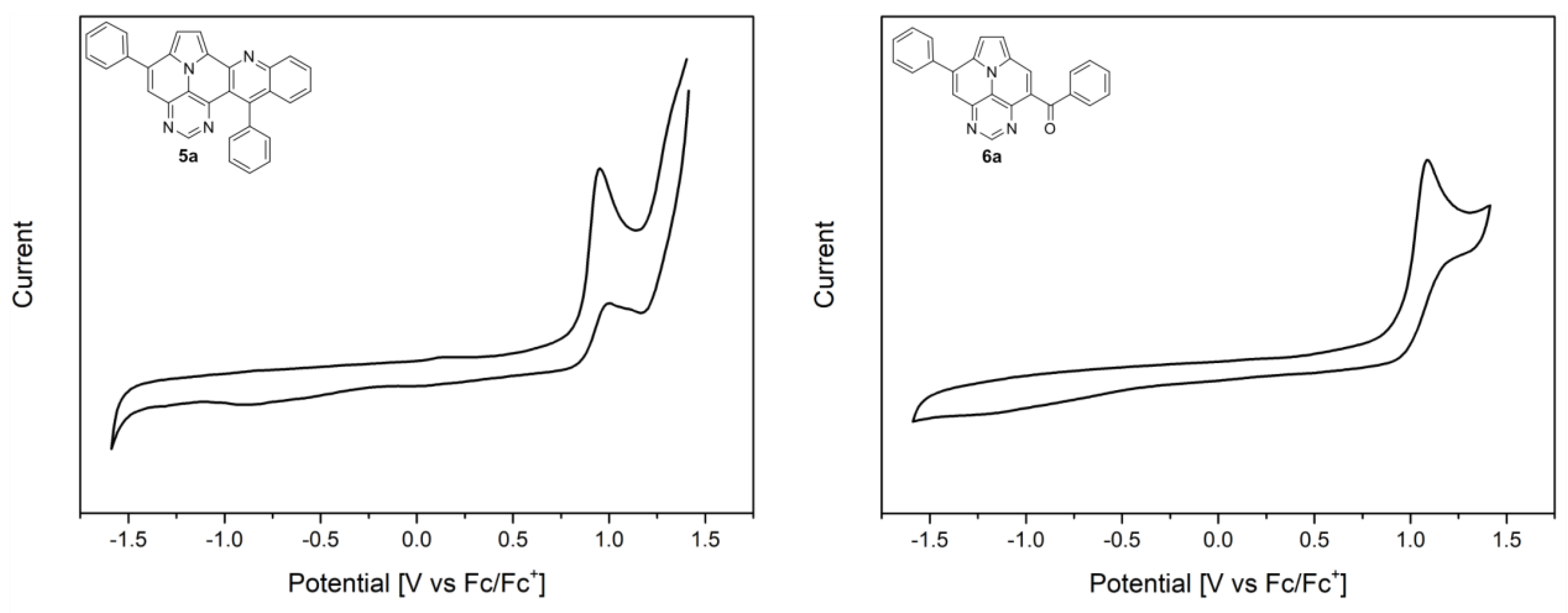
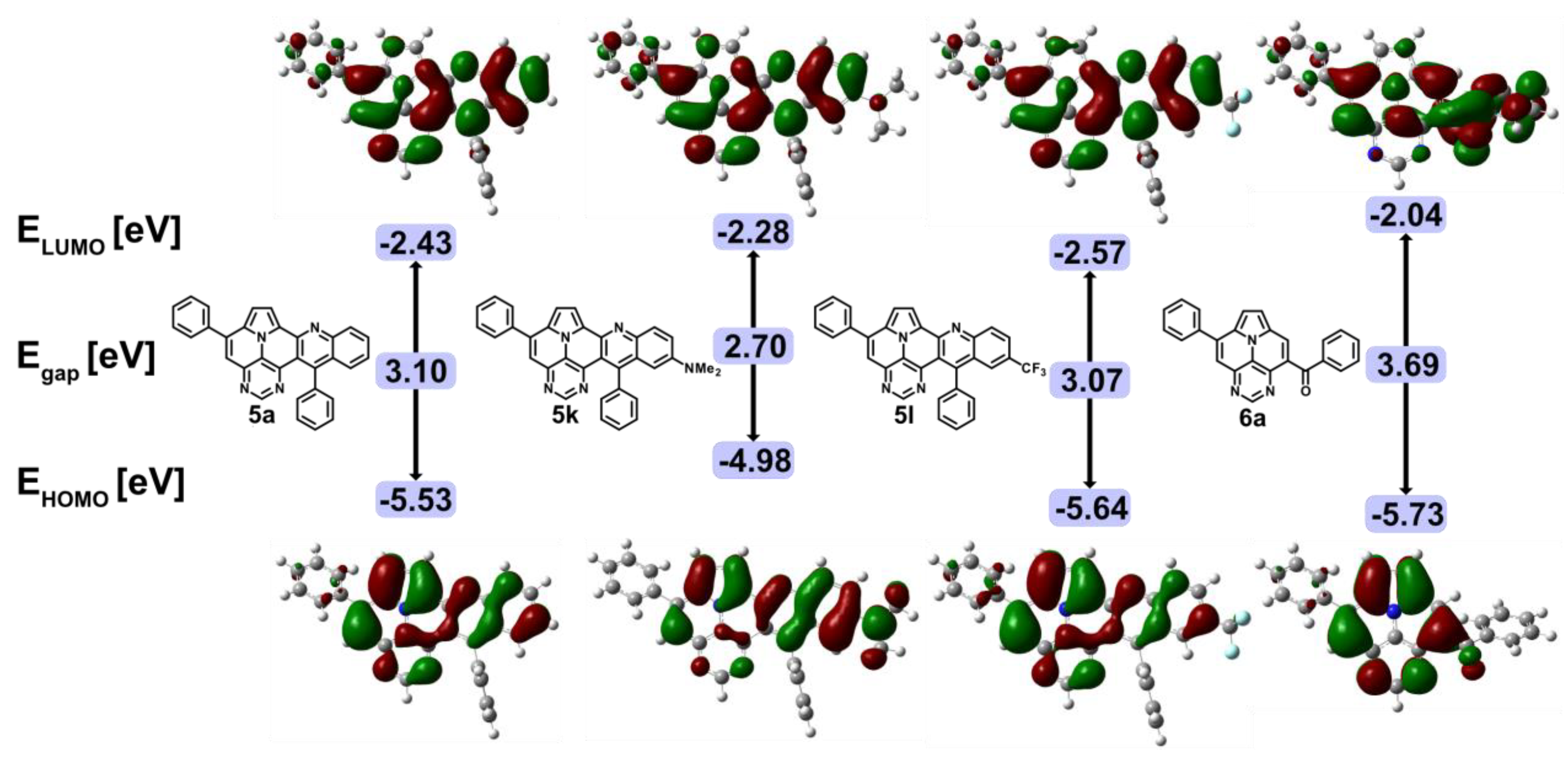
 | |||||||
|---|---|---|---|---|---|---|---|
| Entry | eq. FeCl3 | Acid (eq.) | Solvent | T [°C] | t1 [h] | t2 [h] | Yield [a] [%] |
| 1 | 0.1 | p-TsOH∙H2O (30) | toluene | 100 | 3 | 2 | traces |
| 2 | 0.3 | p-TsOH∙H2O (30) | xylene | 140 | 3 | 2 | 29 |
| 3 | 0.6 | p-TsOH∙H2O (30) | xylene | 140 | 3 | 2 | 34 |
| 4 | 1 | p-TsOH∙H2O (30) | xylene | 140 | 3 | 2 | 38 |
| 5 | 4 | - | xylene | 140 | 3 | - | 21 |
| 6 | 1 | p-TsOH∙H2O (10) | xylene | 140 | 3 | 2 | 23 |
| 7 | 1 | p-TsOH∙H2O (20) | xylene | 140 | 3 | 2 | 27 |
| 8 | 1 | p-TsOH∙H2O (30) | xylene | 140 | 3 | 6 | 45 |
| 9 | 1 | p-TsOH∙H2O (30) | xylene | 140 | 3 | 16 | 45 |
| 10 | 1 | p-TsOH∙H2O (40) | xylene | 140 | 3 | 6 | 43 |
| 11 | 1 | MsOH (30) | xylene | 140 | 3 | 6 | 40 |
 | |||||
|---|---|---|---|---|---|
| Entry | Acid (eq.) | Solvent | T [°C] | t [h] | Yield [a] [%] |
| 1 | p-TsOH∙H2O (30) | - | 120 | 16 | 57 |
| 2 | p-TsOH∙H2O (30) | xylene | 120 | 16 | 68 |
| 3 | p-TsOH∙H2O (30) | xylene | 140 | 16 | 59 |
| 4 | p-TsOH∙H2O (20) | xylene | 120 | 16 | 67 |
| 5 | p-TsOH∙H2O (10) | xylene | 120 | 16 | 53 |
| 6 | MsOH (20) | xylene | 120 | 16 | 27 |
| 7 | p-TsOH∙H2O (20) | xylene | 120 | 6 | 68 |
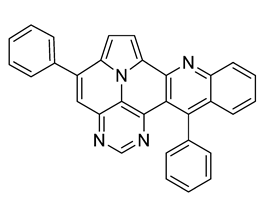 | 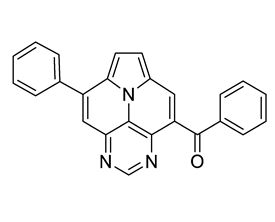 | 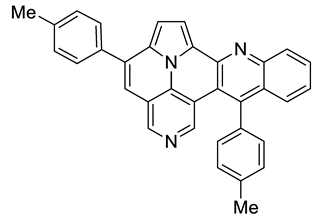 | 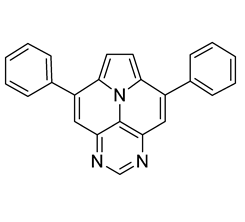 | |
|---|---|---|---|---|
| 5a | 6a | 7 [30] | 8 [29] | |
| λ1,abs [nm] | 497 | 420 | 471 | 422 |
| ελ1 [104 L·mol−1cm−1] | 0.8 | 2.0 | 1.1 | 1.7 |
| λ1,em [nm] | 530 | 462 | 515 | 439 |
| Φ | 0.52 | 0.10 | 0.26 | 0.35 |
| EOx. [V vs. Fc/Fc+] | 0.95 | 1.08 | 0.72 | 1.00 |
| EHOMO/CV [eV] | −5.65 | −5.76 | −5.41 | −5.69 |
| EHOMO/DFT [eV] | −5.53 | −5.73 | −5.22 | −5.60 |
| ELUMO/DFT [eV] | −2.43 | −2.04 | −2.09 | −1.90 |
| Egap [eV] | 3.10 | 3.69 | 3.13 | 3.69 |
Disclaimer/Publisher’s Note: The statements, opinions and data contained in all publications are solely those of the individual author(s) and contributor(s) and not of MDPI and/or the editor(s). MDPI and/or the editor(s) disclaim responsibility for any injury to people or property resulting from any ideas, methods, instructions or products referred to in the content. |
© 2024 by the authors. Licensee MDPI, Basel, Switzerland. This article is an open access article distributed under the terms and conditions of the Creative Commons Attribution (CC BY) license (https://creativecommons.org/licenses/by/4.0/).
Share and Cite
Polkaehn, J.; Ehlers, P.; Villinger, A.; Langer, P. Divergent Synthesis of 5,7-Diazaullazines Derivatives through a Combination of Cycloisomerization with Povarov or Alkyne–Carbonyl Metathesis. Molecules 2024, 29, 2159. https://doi.org/10.3390/molecules29092159
Polkaehn J, Ehlers P, Villinger A, Langer P. Divergent Synthesis of 5,7-Diazaullazines Derivatives through a Combination of Cycloisomerization with Povarov or Alkyne–Carbonyl Metathesis. Molecules. 2024; 29(9):2159. https://doi.org/10.3390/molecules29092159
Chicago/Turabian StylePolkaehn, Jonas, Peter Ehlers, Alexander Villinger, and Peter Langer. 2024. "Divergent Synthesis of 5,7-Diazaullazines Derivatives through a Combination of Cycloisomerization with Povarov or Alkyne–Carbonyl Metathesis" Molecules 29, no. 9: 2159. https://doi.org/10.3390/molecules29092159
APA StylePolkaehn, J., Ehlers, P., Villinger, A., & Langer, P. (2024). Divergent Synthesis of 5,7-Diazaullazines Derivatives through a Combination of Cycloisomerization with Povarov or Alkyne–Carbonyl Metathesis. Molecules, 29(9), 2159. https://doi.org/10.3390/molecules29092159






